On June 15, 2018, I woke up at 5:10 AM, much earlier than normal. A cool night had us with our bedroom window open and the sounds of birds poured in. I could hear the dawn chorus, a time when the birds wake up and announce to all their neighbors, “I am alive, I am still here.” The dominant sound came from the house wren, (Troglodytes aedon) and the song sparrow (Melospiza melodia). The house wren must have been near the window and just would not stop. That did not stop me from falling back to sleep.
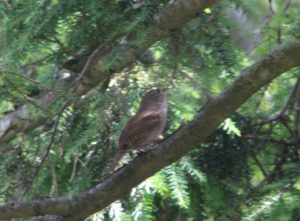
At 6:10 AM, I woke up again, also earlier than normal, and the house wren sang and sang, and sang. Most likely this bird started at dawn and just would not quit. I wondered how long this would go on. I also wondered if the song was always the same and if it changed, could one discern a pattern? I got up, went and got my digital recorder, waited for the minute it takes to turn on, placed it in the bathroom window at 6:13 AM pointed in the rough direction of the wren, shut the door as I left so any noise I made would not be picked up by the recorder, and got dressed. Seven minutes later, I retrieved the recorder. The wren had hardly taken a breath. I took the recorder outside, attached my parabolic mike, and started a new recording at 6:45 AM. This time I could stand on my deck and follow the wren around. I set a goal of taping until the wren tired.
That did not happen. I got tired first and stopped after holding the parabola up for 31 minutes. After repositioning myself, I tried again starting at 7:21 AM. The wren had not stopped. This tape want on for another 8 minutes and 45 seconds. The bird seemed to be slowing down. The real reason I stopped though was the increase in manmade noise. At 7:30 AM, the first leaf blower cranked up. Then an airplane took off from the nearby airport. More and more cars raced down the street behind our neighbor’s house; a shortcut to skip the light.
Audio PlayerLater, I put all of these recordings into a program called Audacity and created sonograms. Now, not only could I hear the bird singing, I could see it and time it and analyze it. In the first recording—seven minutes long—had 77 songs or one about every 5.45 seconds from the start of one song to the start of the next. A song usually lasted a little less than 2 seconds. Most of the gaps between songs were about 3 seconds long. The longest in this 7 minute recording was only 10 seconds.
Audio PlayerIn the first 27 minutes and 30 seconds of the longer recording, the bird sang 257 songs or 6.42 seconds from the start
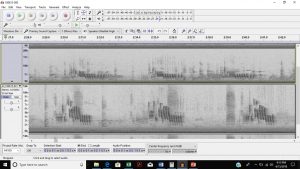
of one song to the start of the next; just a little slower. Since I could see and follow the bird during this recording, I knew that the bird sang while flying. Sang while standing still. It got chased by an American robin (Turdus migratorus) and a few minutes later by a gray catbird (Dumetella caroliniensis), with the wren taking just a short break as it skittered from each. I saw the wren active down low where it moved about incessantly to up high in the tree where it sang for about 15 minutes hardly moving. After that the bird started moving about again, still singing and even grabbed a bite to eat, with hardly a pause to its singing. The wren even gave chase to another house wren. Throughout this observation period, it never stopping its song for more than 10 seconds until 27 minutes and 30 second mark. It then stopped for less than 2 minutes before starting again.
The final recording session resulted in 85 songs in 8 minutes and 35 seconds or 6.6 seconds per song on average. The difference this time was the longer gaps, especially in the beginning. The first song came 3 seconds after I turned on the recorder. The second song started at second 19, the third at second 29.5, with the fourth at 51.5. Those were long gaps. I was thinking the bird was giving up. The rest of the time, the songs came fast and furious with only a couple breaks that lasted about 10 seconds.
Throughout the entire time, I could hear two other house wrens from the neighborhood. Neither as insistent.
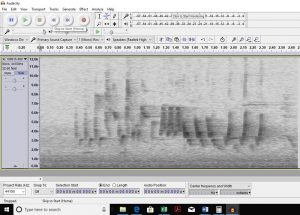
From the visualization of the song, I could see a basic pattern to this bubbly song—a couple high notes followed by a high octave warble, dropping to a lower frequency pattern where the songs descended, and sometimes ending with an note or two or up to five that snapped up sounding like a pop. Interestingly, the snap up ending was the most common sound in the earliest recording, but only happened occasionally in the second longer recording and not at all in the third.
I learned this bird could sing a lot longer than I could listen. I would hear it all morning, but seldom in the afternoon. I knew this bird had marked out my lawn as its territory. It often positioned itself near a wren box I installed on the fence earlier in the year. I could hear other house wrens from two yard down to the south and three yards over to
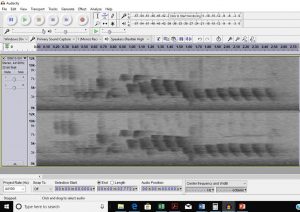
the north.
The fact that this male sung from so high up in the tree indicated his receptivity to mating. If already mated, he would sing from lower in this territory, defending his female from marauding males. Being mid-June, this indicates that this bird either successfully raised a brood already, deserted a female nesting nearby, or wants to have a second mate. The date and the singing of the neighbors has me leaning towards the first possibility, though I did not hear any young house wrens in the yard this year. I know there were at least two nests nearby, but my yard seemed to be on the edge of the territory of the earlier nesting efforts.
Being easily distracted, I also watched a pair (and possibly three blue jays (Cyanositta cristata) feeding a young, recently fledged bird. That tells me that the crows did not clean out all of the nearby nests. While feeding its young, when the jays ended up in my neighbor’s ornamental apple, the jays were attacked by a pair of gray catbirds (Dumetella carolinensis). This happened only when the jays landed in that particular tree. The catbird ignored the baby jay and chased the adults.
Three times during my recording sessions an American robin flew behind my back between me and the house. On one occasion, I clearly saw it carried a beak full of nesting material. The robin was attempting to raise a second brood. Once again, I had not seen a young robin yet this year.
Late last summer, a large mulberry (Morus alba) came down in our yard. For the twenty plus years we lived in this house, the mulberry provided hours of fun observations as it fed a multitude of animals, especially young robins. Were the baby robins gone because of the mulberry or the crows (see previous blog)?
Spending the time to observe what happens in my tiny yard offers me hours of enjoyment. I do not need to go to a huge national park (which I thoroughly enjoy) or even to a local wild area. My little yard in the middle of suburbia offers plenty of discoveries.
Reference:
Johnson, L. S. (2014). House Wren (Troglodytes aedon), version 2.0. In The Birds of North America (A. F. Poole, Editor). Cornell Lab of Ornithology, Ithaca, NY, USA. https://doi.org/10.2173/bna.380
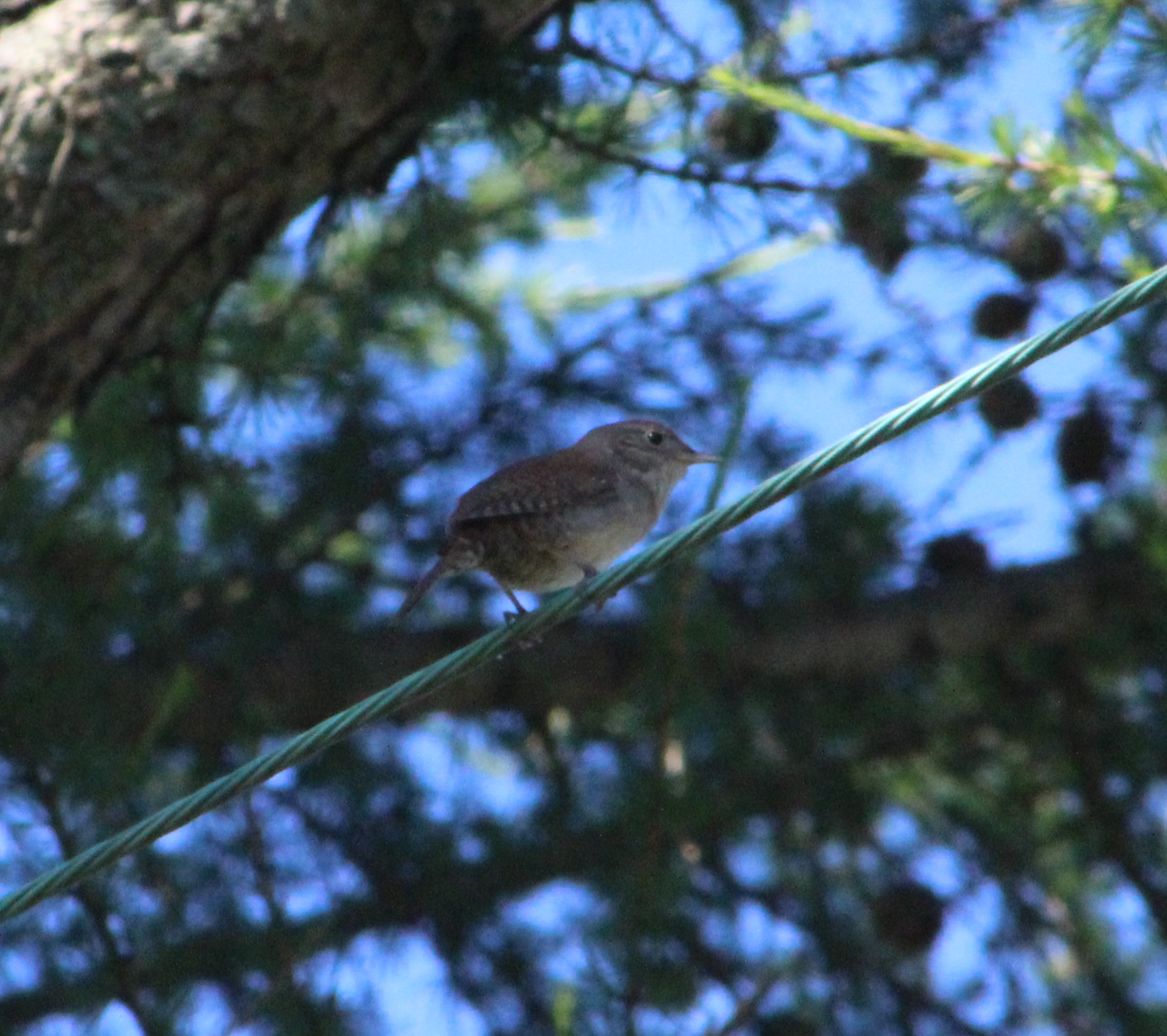
Comments
3 responses to “House Wren Serenade”
So true, Bob! My mother and I have been overwhelmed by the bird activity in her Levittown backyard. There a house wren, I think, continues to return to nest in the space around the air conditioner in the wall. We did observe mating behavior after the young fled the nest. Thank you for your fascinating work. The picture of the scientist with his recorder is a delightful one.
livers. For the good thought. Enjoy those backyard birds.
Very cool, thanks